Mark Sisson's Blog, page 353
December 31, 2012
Dear Mark: Superfoods, BCAAs and Fasted Training, Hot Sauce, and Three More Questions
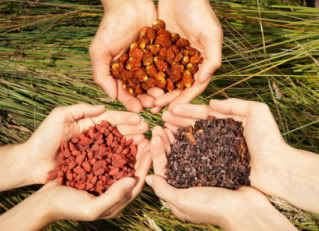 In today’s edition of Dear Mark, I cover six reader questions, starting with one on superfoods. Next is branched chain amino acid supplementation before a “fasted” workout, and whether taking them negates the benefits. Then I discuss whether hot sauce is healthy and Primal, assuming it’s otherwise free of sugary ingredients. Lactase supplementation for lactose-intolerants is next, followed by my advice for someone with a pretty bad leg injury who wants to stay fit while staying off their feet. And finally, I explore the myth of animal protein dissolving your skeletal system as you eat it.
In today’s edition of Dear Mark, I cover six reader questions, starting with one on superfoods. Next is branched chain amino acid supplementation before a “fasted” workout, and whether taking them negates the benefits. Then I discuss whether hot sauce is healthy and Primal, assuming it’s otherwise free of sugary ingredients. Lactase supplementation for lactose-intolerants is next, followed by my advice for someone with a pretty bad leg injury who wants to stay fit while staying off their feet. And finally, I explore the myth of animal protein dissolving your skeletal system as you eat it.
Let’s get to it:
You and Dr. Terry Wahls are my two gurus. She does focus a little more on seaweed and algae than you do, but otherwise you seem in the same boat. I notice neither one of you focus on super foods. Mainly, camu camu, chorella, spirulina, goji berries, hempseeds, bee pollen… I would love to see you do an article on that and would also love the see the reader’s responses. Thanks Mark!
Krista
I’ve written about or mentioned most of those foods before. And they’re all fine or even beneficial to eat, but they aren’t magic. The goji berry won’t give you the power of flight, bee pollen won’t make you a genius, nor will hempseeds turn you into a master hackeysacker. They may be high in antioxidants, vitamin C, or omega-3s, or possess untold amounts of bioactive compounds, which are absolutely attractive and interesting attributes.
Focusing on “super foods” is a mistake. They’re expensive (since you’re paying for all the marketing), for one, and what about the rest of your diet? To focus on an overly expensive, obscure berry or algae may come at the expense of the rest of your diet. You know, those foods where you get the bulk of your calories, macronutrients, and micronutrients. I’m reminded of the famous saying, “Man cannot live on spirulina alone.” Eerily prescient, isn’t it?
By their very nature of being secretive, rare, and special, superfoods are unlikely to exclusively offer a secret nutritional compound that you need to be healthy. You just gotta look around at all the people who’ve ever lived to a ripe old vibrant age without mainlining camu camu extract and realize that these foods probably aren’t essential. There’s nothing wrong with them – and probably a fair bit of right – but if you run out of your hempseed bee pollen butter, you’re not going to suffer deficiencies or become malnourished as a result.
Oh, yeah – watch out for gurus! I’m honored and humbled, and you can certainly learn a lot from other people, and looking up to or respecting them is good, but don’t forget to evaluate everything you read and hear before accepting it. Your journey must be your own. Don’t force morning teaspoons of bee pollen if they give you the sniffles and make you gag.
Hi Mark,
Real quick: is it a good idea to take BCAA’s or not before a fasted workout?
Does it “break the fast” or lower positive effects of completely fasted workouts?
Thanks,
Zach
I’ve mentioned it before – fasting is not an on/off switch. You can have some coffee with a bit of cream and you won’t negate the fast. You can have a hard-boiled egg and few berries and still have a great workout. And yes, you can take branched chain amino acids (BCAAs) without ruining the fasted workout. You may not be technically “fasting,” because you’ve consumed calories, but the benefits will be virtually identical, and you were going to end it anyway after the workout with a post-workout meal. Besides, you already got plenty of benefits from the previous time you spent not eating.
The BCAAs aren’t necessary, of course. If you have them, though, you can take them without ruining your fasted training – and they might even help you preserve muscle. As Martin Berkhan explains, taking BCAAs in a fasted state pre-workout reduces the fasted training-induced breakdown of muscle protein while preserving the fasted training-induced anabolic boost. There’s also evidence that pre-workout protein (or BCAAs) can increase fat loss.
It depends on the workout, too. Folks seem to get more out of BCAAs before a fasted strength workout than a fasted sprint workout. I’m the same way. If it’s some quick sprint work or a nice long hike, I like it on an empty stomach. If I’m lifting something heavy or exerting myself for an extended period of time (like Ultimate Frisbee), I usually like a small bite or shake (usually a couple scoops of Primal Fuel) beforehand.
BCAAs will turn off the autophagy induced by fasting (but this is necessary for building muscle); just a few grams’ worth is sufficient. So don’t sip on BCAAs in the middle of the fast, but taking them right before you’re about to end it – with a big meal after your big workout – shouldn’t be an issue. They’re also good at preserving muscle during an extended fast (24 hour +).
I understand I should avoid regular ketchup, bbq sauce, anything that contains corn syrup. But can I have hot sauces and any other sauces that don’t have high fructose corn syrup in the ingredient list? I love hot sauce, especially Sriracha, Tapatio, Tabasco, hot salsa etc…
Sophie
If you enjoy and can tolerate the heat, enjoy your hot sauces. You might want to be wary of eating whole habeneros raw, but spicy food is perfectly Primal. There’s some evidence that capsaicin (the compound that gives peppers their heat) can increase intestinal permeability and generally cause gastrointestinal irritation. In sprinting (already an independent inducer of transient intestinal permeability - PDF), for example, capsaicin supplementation is contraindicated because of GI distress.
If you love hot sauce, it’s probably not negatively affecting your digestion (or else you wouldn’t love it), so I say have at it. If you find post-hot sauce bowel movements are starting to feel like spitting fire, that’s probably a sign that you should reduce your intake. Until then, I wouldn’t worry.
One small note: corn syrup is different from high-fructose corn syrup, with the former being a more benign sweetener composed mostly of glucose rather than fructose. Limit both, but don’t feel the need to run shrieking from the room when plain ol’ corn syrup comes sauntering in.
Can the negative and inflammatory effects most experience with milk be negated with a lactase supplement to process the lactose, or will this not work?
Kevin
That depends entirely on whether you’re sensitive to the lactose or to some other dairy constituent, like casein.
If it’s lactose, most accounts suggest that lactase supplements are effective in allowing lactose-intolerant individuals to process the lactose. Over the counter supplements like Lactaid work well, and if it’s a real serious problem you can probably get a prescription for a drug called Tilactase, which seems to perform even better in studies of lactose-intolerant individuals.
So, yeah – it won’t negate the bad effects in everyone, but it’s effective in lactose-intolerant people.
Dear Mark and Awesome Worker Bees,
I broke my leg pretty severely in October. I had a compound fracture in my fibula that dislodged my ankle, breaking it as well, tearing ligaments, popping tendond and all that other general nastiness.
I currently am playing host to a small minefield of pins and plates. My boyfriend says I’m bionic.
While I’m stubbornly on my way to recovery, my doctor has advised my that my regular path of primal living, especially the high impact playing I usually love to do, is out of the question for at least the next three months.
Obviously, I know I can’t do sprints on a broken leg. Can you give me a few tips to keep myself fit while remaining primal? I want to do this the smart way and I want to heal as best as I can, but I am nervous about gaining a lot of weight while I’m down.
Thanks!
Jennifer
First off, listen to your doctor and stick with the physical therapy, including doing what the therapist wants you to do. They’re generally well-versed in this sort of thing.
Think low impact, at least to start. Stationary cycling and swimming will be your friends, provided you get clearance.
Work on your upper body strength. Stuck on a solid dead hang? Take this as an opportunity to really nail your pullups or chinups. Pushups may be out of the question (unless you do them one footed), so try to do some dips. In a pinch, a walker makes a great dip station and can often be found at thrift shops for cheap.
Most of all, accept that you’re going to slightly regress in areas of fitness that involve and depend on the lower body. Just know that it’s not permanent and that you can actually improve in other areas (like the upper body).
This may be redundant advice, but since you generally want to tailor your carb intake to your activity level (which will be rather low), you’ll also want to stay on the low-carb side of things at least until you’re able to resume normal activity.
Recently diagnosed with osteoporosis in the spine and hips. I have been eating paleo for six months and have started following your weekly lifestyle plan. Do I need to add to this to help rebuild bones? I have already added dead lifting into the basic exercise moves. I have also seen so many varied reports on the effect of meat protein on the bones? What are your thoughts?
Anne
Quite simply, the claim that eating animal protein leads to osteoporosis is wrong. The idea springs from the fact that meat intake increases urinary calcium excretion, which makes it look like you’re dissolving your bones and peeing out the calcium. What’s really happening, however, is that meat protein intake increases calcium absorption from other foods, providing an “excess” of calcium that must be excreted through the urine. This is a normal reaction to a surplus of minerals. In fact, a diet high in animal protein increases calcium absorption and excretion without affecting the biomarkers that really tell us whether bone demineralization and osteoporosis are actually happening: those of bone resportion and formation.
A recent meta-analysis even concluded that “consuming protein (including that from meat) higher than current Recommended Dietary Allowance for protein is beneficial to calcium utilization and bone health, especially in the elderly.”
That’s it for today, folks. Hope you have a great new year and thanks for reading!
Get Your Copy of Primal Blueprint Healthy Sauces, Dressings & Toppings Today!

December 30, 2012
Weekend Link Love
 First off, I’d like to let you all know that anyone who pre-orders The Primal Connection before the giveaways are announced next week will still receive the bonuses (or “boni,” as Mr. Burns would say) associated with the offer. So if you’re eager to get ordering, don’t think you’ll miss out.
First off, I’d like to let you all know that anyone who pre-orders The Primal Connection before the giveaways are announced next week will still receive the bonuses (or “boni,” as Mr. Burns would say) associated with the offer. So if you’re eager to get ordering, don’t think you’ll miss out.
One more quick announcement: Tomorrow’s the last day to get two free books (The Primal Blueprint 90-Day Journal and The Primal Blueprint 21-Day Total Body Transformation) when you order Primal Fuel at the new, lower cost, so if you’ve been wanting to try Primal Fuel there’s no better time than now.
Research of the Week
In a new study, rodents on a gluten-free diet gained less fat and overall bodyweight than rodents on an otherwise identical diet that contained gluten, despite eating the same amount of food and excreting no additional lipids.
Another interesting rodent study found that rats eating yogurt artificially sweetened with either saccharin or aspartame gained more weight than rats eating yogurt sweetened with regular sugar, despite eating the same number of calories.
Interesting Blog Posts
Are you an antsy desk jockey who’s still dissatisfied with the standing desk? Chris Kresser explains how you can walk 10,000 steps a day while working at the computer.
Paul and Shou-Ching explore the possible dietary causes of violence in humans.
Media, Schmedia
Why you should probably stop eating wheat.
Everything Else
Sometimes (all the time), you just need to do the thing that you’re talking/reading/arguing/looking up arcane studies about.
Tim Ferriss and Leo Babauta each take a very different approach to goals and goal-setting.
Recipe Corner
When the kids are clamoring for chicken nuggets, these are a good alternative to breaded and deep fried pink poultry slushies.
A nutrient-dense, breadcrumb-free meatloaf just like your grandma made for you, if Sally Fallon was your grandma.
Time Capsule
One year ago (Dec 30 – Jan 5)
What is Inflammation? – We talk enough about it… but what exactly is it?
How Much Have Human Dietary Requirements Evolved in the Last 10,000 Years? – Sure, there’s been some evolution. But that doesn’t mean you’ve adapted to eating grains, corn oil, and guzzling cola.
Comment of the Week
I know I always have caveman on the brain…
My new bumper sticker: “Paleocephalus – Catch It!”
- I’m sure they’ll whip up a vaccine for that one real quick.

December 29, 2012
Primal Cassoulet
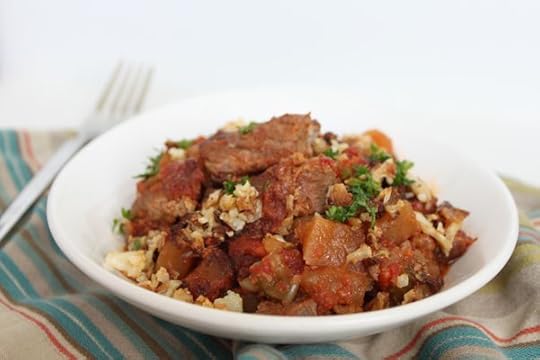 Cassoulet is often thought of as a massive undertaking that requires days to cook. It’s also often assumed that cassoulet can’t be made without beans. In this Primal version, neither is true. In a few hours you’ll have one of the meatiest meals imaginable. Incredibly rich and hearty with layers of different flavors, this is a meal not to be missed.
Cassoulet is often thought of as a massive undertaking that requires days to cook. It’s also often assumed that cassoulet can’t be made without beans. In this Primal version, neither is true. In a few hours you’ll have one of the meatiest meals imaginable. Incredibly rich and hearty with layers of different flavors, this is a meal not to be missed.
Cassoulet is made with all kinds of meat and can get a little pricey, depending on what you choose. This recipe is mid-range, as it blends pork shoulder and sausage, duck, and bacon. You can go all out and use more duck or even duck confit. You can scale back and add more pork shoulder and no duck at all. Or, you can use lamb if you want.
At this point, if you’re starting to feel like cassoulet is a casual one-pot meal that’s improvised depending on what’s on hand, then that’s good. This is not fancy French food, it’s French comfort food, so there’s no reason to be intimidated…even after you glance below and see how many ingredients and steps are involved.
Don’t sweat it. This is an easy version of cassoulet. All the recipe really involves is buying a bunch of meat and vegetables, chopping them up, browning everything and then simmering for several hours. This is cassoulet for people who don’t have time to spend three days cooking, but still want a big flavor pay-off at the end.
The beans usually found in cassoulet are replaced here with rutabaga, a root vegetable with a sweet, earthy flavor and creamy texture that is surprisingly close to beans. And oh, yeah, about that traditional bread crumb topping….you don’t really need that either. Try finely chopped oven-roasted cauliflower instead to give your cassoulet a toasted, buttery finish.
Servings: Six to eight
Time in the Kitchen: One hour of active cooking time, plus two hours of simmering
Ingredients:
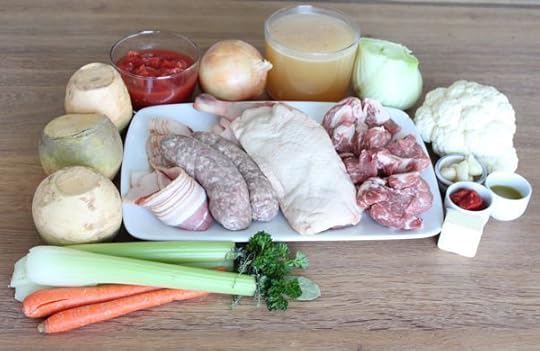
2 tablespoons butter (30 ml)
1 pound pork shoulder, lightly seasoned with salt and pepper, cut into 1-inch cubes (450 g) (25 mm)
1 pound of duck legs or breasts (breast works much better for recipe, unless you want to splurge and buy duck confit) (450 g)
8 cloves of garlic, thinly sliced
1 onion, finely chopped
4 celery stalks, chopped
2 carrots, chopped
1 fennel bulb, thinly sliced
2 tablespoons tomato paste (30 ml)
1 pound pork sausage (sweet Italian works well) cut into 1/2 inch slices (450 g) (12 mm)
1/2 pound pancetta or bacon, cut into small pieces (230 g)
2 cups whole peeled canned tomatoes, broken up with your hands (300 g)
2 to 3 cups chicken stock (500 to 750 ml)
2 rutabagas, peeled and chopped into 1/2-inch cubes (12 mm)
1 bay leaf, 4 sprigs of parsley and 4 sprigs of thyme tied together with twine
1/2 a head of cauliflower
2 tablespoons olive oil (30 ml)
1/4 cup finely chopped parsley (60 ml)
Pinch of sea salt
Instructions:
Melt the butter in a Dutch oven or other ovenproof pot (five quart or more) over med heat.
Add the pork and brown on each side, about six minutes total. Remove the pork from the pot.
Add the duck and brown, about eight minutes. Remove from pot.
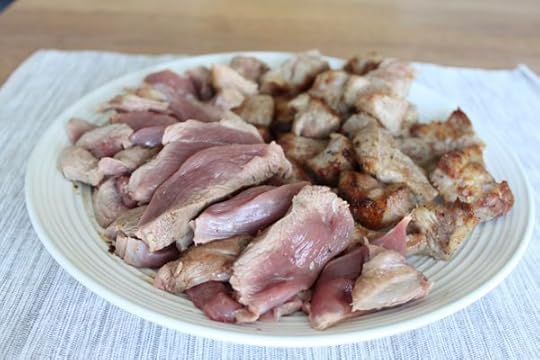
When it cools, pull the meat off the bones (if using legs) and shred. If using the breast, simply slice the meat into chunks. The skin can be discarded or left on. It will add flavor to the dish, but also a lot of fat.
Turn the heat up to medium-high under the pot. Add the garlic, onion, celery, carrot and fennel. Cook until lightly browned, about ten minutes.
Add the tomato paste and mix well.
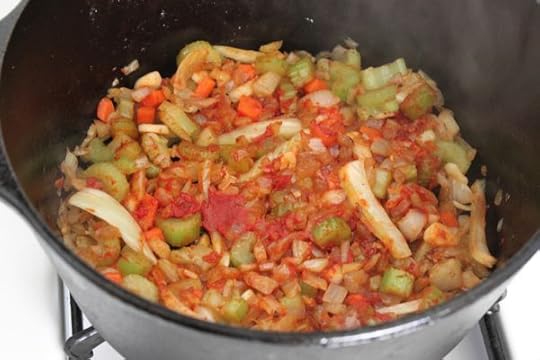
Add the sausage and pancetta/bacon to the pot. Cook five minutes until sausage is browned. Add pork and duck back to the pot.
Add the tomatoes and simmer for ten minutes.
Add two cups of stock, the rutabaga, and the bundle of herbs and bring to a boil. Push the rutabaga and meat down with a spoon so they’re mostly under the liquid.
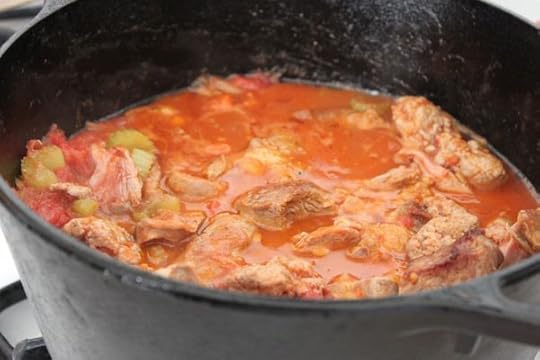
Reduce heat to medium-low and simmer, uncovered, for one hour.
While the cassoulet is simmering, make the cauliflower topping. Preheat the oven to 400 °F (205 °C). Cut out the inner core of the cauliflower and slice the cauliflower thinly. Toss with olive oil. Lay the cauliflower in one layer on a rimmed baking sheet. Bake (don’t stir it!) until really brown and crispy around edges, about forty-five minutes.
Take out and set aside. Chop up finely and mix with the parsley and a pinch of sea salt.
Reduce the oven heat to 350 °F (176 °C)
When the cassoulet is done simmering on the stove, remove the bundle of herbs. If you prefer a brothy cassoulet (rather than one with no broth remaining) then add the remaining cup of broth right now.
Put the pot in the oven and bake, uncovered, for roughly one hour and fifteen minutes. There is no need to stir it.
Sprinkle the cauliflower on top of the cassoulet. Place under the broiler for a few minutes to warm the cauliflower and brown the top of the cassoulet.
Serve immediately or over the next few days – it gets even better with time.
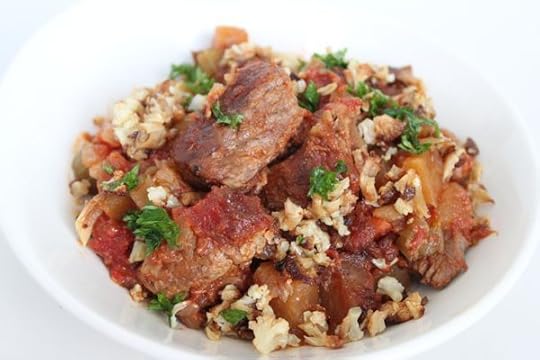
Get Your Copy of Primal Blueprint Healthy Sauces, Dressings & Toppings Today!

December 28, 2012
I Feel Like a Normal Human Being Again
It’s Friday, everyone! And that means another Primal Blueprint Real Life Story from a Mark’s Daily Apple reader. If you have your own success story and would like to share it with me and the Mark’s Daily Apple community please contact me here. I’ll continue to publish these each Friday as long as they keep coming in. Thank you for reading!
 My primal story starts about nine months ago. It was December, and we had just been visited by both of my brothers. My brothers’ visits usually consist of copious amounts of eating and drinking. We’re generally healthy folk – we exercise regularly and try to eat a balanced diet. But when we get together, we drink lots of beer and eat lots of delicious fried food. Well, the unhealthy binging was starting to catch up to me, and I was topping out at 147-149 (I’m 5’ 6”), a solid five pounds more than my usual fighting weight.
My primal story starts about nine months ago. It was December, and we had just been visited by both of my brothers. My brothers’ visits usually consist of copious amounts of eating and drinking. We’re generally healthy folk – we exercise regularly and try to eat a balanced diet. But when we get together, we drink lots of beer and eat lots of delicious fried food. Well, the unhealthy binging was starting to catch up to me, and I was topping out at 147-149 (I’m 5’ 6”), a solid five pounds more than my usual fighting weight.
In addition to being constantly uncomfortable due to the tight pants, I was also struggling with some serious anxiety issues. I would get anxious over the silliest things – waiting in line at the grocery store, stopping at a red light, walking through the mall, etc. I always felt as if I was going to pass out or spin out of control. I finally talked to my awesome nurse practitioner/chiropractor and realized my issues were caused by allergies clogging up my head something fierce. I was able to get some relief through her treatments, but I still wasn’t feeling 100% normal.

While trying to find a non-prescription solution to my problem (my MD wanted to prescribe anti-anxiety meds, of course), I ran across an article about eating primally in my Lifehacker RSS feed. I followed the links to Mark’s Daily Apple and was super intrigued by what I read. I ordered the 21-Day Total Body Transformation and instantly identified with what the book said. This was a “diet” I could get behind – one where I could eat the foods I enjoy and not have to count calories. The whole approach also meshed with other things I care about – eating locally grown food, living a simple life, and disconnecting from the Matrix.
I started the 21 days in early January (after binging on carbs and drinks, of course). Within the first couple of weeks, I had lost a couple of pounds and realized that I was no longer waking up in the middle of the night, filling 10 tissues with green slime. Gross, I know. About 11 days into the diet, I had to go to a holiday party, so of course I drank. That very night I woke up in the middle of the night, snot just pouring out of my nose. I’m sorry to be graphic, but it’s true. A light bulb went off – my body does not like alcohol (or gluten – surprise!!)!
I got such great results in those first few weeks, that I just kept following the plan over and over again. I think I did it three times in a row. It’s nine months later, and I’ve slacked off a bit on following the exact plan, but I still eat primally, I run at a slow pace three to four times per week and do pushups, squats, planks, and pull-ups at least three times a week. When I started I couldn’t do one real pushup – now I can do seven. I could only do a flexed arm hang, and now I can do two pull-ups. I can do a plank for 90 seconds, and I can do 25 squats with 20 pounds. I’ve lost 20 pounds, so I’m at 129 at 5’ 6”. I went from a size 10 to a size 4. I have TONS more energy. I no longer want to fall asleep at my desk in the afternoon. Best of all, my anxiety levels are WAAAAY down. I feel like a normal human being again – no longer petrified to be caught at a red light. I cannot describe how good it feels to be relieved of that fear.
So I proselytize. To anyone who will listen, I tell them how eating primally is, “good for what ails ya.”
What’s bad about primal living? Well, it definitely takes more planning, but it’s so worth it. The food I make at home tastes way better than the food we get going out. I also don’t know what to say when people say, “You’re so skinny!!” Um, thanks?? And change the subject. I also get made fun of mercilessly by my coworkers for my diet. They help keep me on track by judging me if I eat an occasional non-foraged doughnut or slice of homemade pumpkin bread. I’m sure they do it out of love.  I actually got one of my coworkers interested in the diet. However, she Googled Primal Recipes, and the first one she ran across was “Tender Grilled Baby Octopus.” And…she was out.
I actually got one of my coworkers interested in the diet. However, she Googled Primal Recipes, and the first one she ran across was “Tender Grilled Baby Octopus.” And…she was out.
I am so glad I found MDA. It really has changed my life! Thank you, Mark!! Like everyone else, I blogged about my experience. If you want more details, check it out here: HloDeCello.
Some stats:
Starting weight: 149.3 pounds, Chest 36 inches, Waist 31 inches, Hips 43 inches
Ending weight: 129.6 pounds, Chest 34 inches(sorry Hubby!), Waist 28.25 inches, Hips 38.5 inches
I’ve attached before and after pictures. I wasn’t really portly to start with, but I wasn’t thin or toned enough to want any photos taken of me in a bathing suit! After eating primally for six months, however, I happily bought a string bikini while on vacation on Ocracoke Island and let the hubs snap a pic.

Heather
Grab a Copy of The Primal Blueprint 21-Day Total Body Transformation and Start Getting Primal Today!

December 27, 2012
Primal Actualization: Realizing Your Inner Potential
 If the earlier holidays of the season are more socially-driven, New Year’s is the more personal, the more private. Sure, there are the parties, the throngs in Times Square, and the general cycle of media hoopla surrounding New Year’s Eve, but the real crux of this annual event is contemplative. The party hats and noise makers have their heyday for a few hours (for some of us the hangover claims a few more). But the more insistent, pensive theme of the holiday is the part that lingers – first drifting into our psyches after the bigger festivities have cleared away and the guests have all gone home.
If the earlier holidays of the season are more socially-driven, New Year’s is the more personal, the more private. Sure, there are the parties, the throngs in Times Square, and the general cycle of media hoopla surrounding New Year’s Eve, but the real crux of this annual event is contemplative. The party hats and noise makers have their heyday for a few hours (for some of us the hangover claims a few more). But the more insistent, pensive theme of the holiday is the part that lingers – first drifting into our psyches after the bigger festivities have cleared away and the guests have all gone home.
Even if we scoff at the concept of resolutions, no amount of cynicism can keep us from at least entertaining the thought of a new year as a new beginning. After all, there’s something universally hopeful and tantalizing about a transition. We can’t help but think of the possibilities: “Maybe this year….” In some cases, we may just be grateful to kiss the current year goodbye. (We all have those times.) But even if we’ve just wrapped up a pretty decent year, we ascribe to the New Year’s potential for change. On some level, we allow it to influence our hopes – and outlook – on the coming year.
Personally, I think this is a good thing. Grok and his kin undoubtedly celebrated the natural transition of the seasons and the metaphorical narratives that they designed in connection to them. It’s human to seek out beginnings. I’ll of course offer up a more traditional call for the New Year next week, but I wanted to throw out something more nuanced and inexact than a “resolution,” something akin to vision, a musing that I call “Primal actualization.”
When we talk about self-actualization, we usually think of it in the psychological sense (related but not limited to Maslow’s definition) of realizing our highest personal potential, which for many of us tends to pigeonhole us into specializing in a particular endeavor. (I will be the reigning ping-pong player in all of history!) Truth is, actualization in many respects contradicts such a narrow mindset of specializing. Actualization, in fact, encompasses a broad spectrum, influencing everything from one’s capacity to bond with other people to the ability to develop perspective on life and society, from pursuing a creative pursuit to witnessing the profound details in any given moment. I’d argue it’s a kind of open-ended wisdom that is fully engaged with life. Sounds like a great goal, eh?
I know I always have caveman on the brain, but I can’t think of actualization without contemplating the primal undertones. Too often we cast self-actualization as transcending beyond of our “lesser” or “baser” selves. In the traditional hierarchical view, actualization is a process not just higher but separate from the fulfilling of lower needs like eating, sex, and socialization. But what if we looked at self-actualization less as a rising above our humanity and more as a living the full measure of it?
Living our full humanity includes honoring the primal rhythms and genetic expectations that course through us, vestiges of our evolutionary roots and directives of our primal operating systems. It means embracing the wisdom of our ancestors not just as anthropological origins but as wellsprings, for a fulfilled and healthy life. It means allowing ourselves to explore and exercise our primal dimensions by spending time in the wild, getting ample sun, and playing every day.
Primal, in other words, is more than just a metaphor. When we live and connect Primally, we actively access our inner potential. We harness the power of the mind-body connection, the effects of flow and euphoria, the energy of sensory experience. When we approach it primally, actualization can feel like potent therapy in the modern world.
So, what would it be like to Primally actualize our relationships with others this year? How about devoting the year to Primally actualizing our relationship with sleep or food or our pursuit of play? I mean more than just trying it or working it in here and there but making a point of “realizing” its full potential in our lives. When we live each day discovering and unfolding these deep layers of our humanity, we’re inevitably changed. In unearthing ourselves, we come into our own. I’ve heard readers say it feels like a homecoming of sorts.
What is possible when we envision living by this compass in the coming year? How could we find ourselves changed next New Year’s? What would Primal actualization, living the fuller measure of humanity, mean for you? It isn’t a resolution, per se, but a way of re-envisioning the potential impact of a year’s time and purpose.
Thanks for reading, everyone. Share your thoughts and comments on making the new year Primal.
The Sequel to The Primal Blueprint Releases on January 8
 In just two weeks I’ll be releasing The Primal Connection, the long-awaited sequel to The Primal Blueprint. As friends and colleagues within the ancestral movement have so generously described, The Primal Connection offers the first really new dimension in the paleo/Primal space in years. Is there any better way to start the new year – not to mention the fact that we all survived the Mayan apocalypse? In all seriousness, I’ve been pumped about this launch for months now.
In just two weeks I’ll be releasing The Primal Connection, the long-awaited sequel to The Primal Blueprint. As friends and colleagues within the ancestral movement have so generously described, The Primal Connection offers the first really new dimension in the paleo/Primal space in years. Is there any better way to start the new year – not to mention the fact that we all survived the Mayan apocalypse? In all seriousness, I’ve been pumped about this launch for months now.
Like The Primal Blueprint, The Primal Connection is both a culmination and expansion of principles I’ve first introduced here on MDA. It picks up where The Primal Blueprint left off, by extending the primal theme beyond the diet and exercise basics. In it I present a comprehensive plan to overcome the flawed mentality and hectic pace of high-tech, modern life and reprogram your genes to become joyful, care-free, and at peace with the present. Inherent to The Primal Connection is the concept that we can use the model of our ancestors to create not just a healthier existence but also a more balanced and fulfilling life. My hope is that upon reading it you’ll emerge with a renewed appreciation for the simple pleasures of life and our most precious gifts of time, health, and love.
Just as I did for Primal Blueprint Healthy Sauces, Dressings & Toppings earlier this month, I’ll have something special put together for devoted Mark’s Daily Apple readers when this book is released on January 8th, 2013. So mark your calendar and be ready to jump on the offer while it lasts.
P.S. If you’ve pre-ordered a copy of The Primal Connection, don’t worry. All pre-orders will be eligible to receive the free bonuses that will be part of the book release offer.
Don’t Miss It! Receive an Email Alert When the Limited-Time Offer is Announced by Subscribing to the Mark’s Daily Apple Newsletter

December 26, 2012
21 Simple Things to Do to Prepare for a Successful 2013
 Well, the apocalypse never came. No earth-rending seismic activity rearranged geography. Nary a tsunami wrought despair and destruction on coastlines, nor did the turn of the calendar awaken an ancient, many-tentacled evil force hidden deep below. We experienced neither a global awakening of consciousness, a visit from the original extraterrestrial architects of our physiology, nor an explosion of eschatological novelty. What that means is two things: the prophets of 2012 got it wrong, and you have to plan for the rest of your life.
Well, the apocalypse never came. No earth-rending seismic activity rearranged geography. Nary a tsunami wrought despair and destruction on coastlines, nor did the turn of the calendar awaken an ancient, many-tentacled evil force hidden deep below. We experienced neither a global awakening of consciousness, a visit from the original extraterrestrial architects of our physiology, nor an explosion of eschatological novelty. What that means is two things: the prophets of 2012 got it wrong, and you have to plan for the rest of your life.
Let’s start with 2013. How are you going to make sure it’s a successful year? What steps will you take?
I’ve got a few suggestions. This may seem a bit untimely coming on the heels of Christmas Day, but I wanted to encourage you to start thinking about where you’ve been and where you’re going. Whenever you have some time off from family and friends, consider getting some thinking done. Consider taking a few preliminary steps toward making 2013 a good year.
1. Install F.lux on your computer.
It takes a minute. It’s free. It will have a measurable impact on the quality and duration of your sleep, which will set the stage for health and productivity. There’s literally no reason not to install F.lux (even if you’re going to be photo-editing or something that requires the full spectrum, you can always turn the program off for a bit).
2. Buy blue-blocking glasses.
F.lux is great, but it only works on select electronic devices. What about everything else, like the TV, that light overhead, or (if you’re willing to look a little strange) the grocery store after dark? Glasses that block blue light will help you to go about your business in this modern life without pushing back your melatonin secretion, allowing you to get to bed at a reasonable time.
3. Find a local grass-fed beef supplier.
Grass-fed beef makes a big difference. It really does. And yes, it’s generally more expensive than grain-fed beef, but if you find the right local supplier and buy directly from them, you can get a better deal.
4. Buy a chest freezer.
If you’re going to switch to grass-fed beef and want the best deal you can find, you’ll want a chest freezer to enable bulk buying (or even cowpooling). You’ll save money and have steady access to good meat, but it’s also fun to weird out visitors with your giant meat locker. Bonus points if you position a sheep’s head such that it’s looking right into the eyes of whoever opens the door.
5. Buy a journal.
A journal gives you access to a free, unlicensed (but effective) therapist, and it allows you to conduct real n=1 experiments to figure out what works for you – and why. If you want to make any changes in the new year, a journal will help you make sense of them.
6. Get a library card.
Part of having a successful year is focusing on the mind – not just the body. I love reading and find books to be a quite powerful influence on the mind. If you think you’re in the same boat, go grab a library card – they’re usually free and woefully underutilized – so that you can start the influencing off right.
7. Find out where and when all the local farmers markets are.
So you’ve long told yourself that you’re going to “start shopping at farmers markets more,” but it never really materializes. That stops in 2013. To help your chances, compile a list of all the local farmers markets. Figure out where they are, when they run, and which ones fit into your schedule. You won’t be able to avoid going if you can’t make up a ridiculous excuse like “I don’t even know when it is!”
8. Treat yourself to a few quality cooking tools.
A good knife, a well-made wooden cutting board, and a solid enameled cast iron pot don’t just make cooking good food easier, they make it more enjoyable. If you want to start cooking more but haven’t been able to really get going, the first step is to get cookware that’s worthy of the food you’ll be making.
9. Find an Asian market near you.
Asian markets are teeming with interesting, delicious, nutritious, unique (at least to many people) foods. Want fresh (often living) fish and shellfish? Check out the seafood section. Want twenty different kinds of leafy greens? Check out the produce section. Want that spice or herb whose health benefits you read about on some blog somewhere? Check out the spice section. Having an Asian market nearby will be a helpful ally in the coming year.
10. Look for a seafood wholesaler.
If you’re lucky enough to have a seafood wholesaler near you, take advantage. You’ll be able to get oysters, crab, fish, and other sorts of sea creatures almost directly after they’re caught/harvested without the few days of lag time that can make a huge difference. Seafood is a big part of a healthy Primal eating plan, so be sure to have a good source.
11. Browse Meetup.com for relevant local groups.
Blogs and Facebook and Twitter aren’t enough for us. We are social animals, after all, who need face to face contact. If your friends think you’re insane for eschewing grains and buying bulk butter, check out Meetup.com for relevant groups (paleo, Primal, hiking, weightlifting, camping, etc.) and then go join them.
12. Start drafting a Friday “Success Story” to submit.
Write the first paragraph in which you give your background, your experience hitherto, your justification for wanting to do it all better. Then, finish the story in 2013 – and make it a good one.
13. Join a gym if you haven’t.
I prefer working out in nature, preferably doing something I love like Ultimate Frisbee or stand up paddleboarding, but not everyone’s like that. A lot of people need the gym atmosphere – not to mention the equipment – to get a good workout. Plus, paying money for something will often get you to use it. Sure, a lot of gyms fill up around New Year’s with temporary fitness buffs, only to empty out around the middle of February, but I think MDA readers are a different sort. And hey, I still go to a gym to do certain things; it’s just not my favorite way to exercise.
14. Browse Craigslist for used fitness equipment.
Some people need to join a gym in order to get a workout, but others find home gyms work best. If you’re of the latter group, Craigslist is a fantastic place to get great deals on quality equipment. Try searches like “barbell” or “kettlebell” or “weight vest” or “squat rack” or any other equipment you covet.
15. Find info on all the adult sports leagues nearby.
You know you “need to play more,” but how? You can’t just head down to the local park as a grown adult and join a random game of tag with a bunch of other adults out playing. See, until we reach critical mass and get most adults out there ready and willing to play, you’re gonna have to search out play-willing adults. Find some adult sports leagues for the coming year to help you play more in 2013. If you’re a ten-year old reading this, enjoy your ample supply of willing peers (cause it won’t last forever).
16. Clean out your fridge and freezer.
That half-eaten avocado with a spoon still sticking in it from last week? Toss it. The container of Greek yogurt you left cracked open so that part of the top layer crusted over? Get rid of it. That congealed red hemoglobin slick from the time you thawed a roast and never cleaned it up? Clean it. Get rid of all the old greens, rearrange the inefficient jumble of containers, and clear out the freezer to make way for all the fantastic food you’re going to be eating, making, and storing in 2013.
17. Get your knives sharpened.
I know most of you aren’t doing this regularly. If you haven’t gotten your knives sharpened recently and you aren’t one to maintain them yourself, take them to get professionally sharpened. It will make a huge difference, and cutting meat and slicing veggies and fruits will become a pleasurable act.
18. Spend a day or two recharging in nature.
Go for a long hike, take a weekend trip out in the woods, camp on the beach, rent a cabin. Just spend an extended amount of time away from civilization, deep in wild nature. Think about your big plans for 2013, or just use the time to do nothing but experience nature (perhaps with a spiritual encounter or two) and get away from it all. Whatever you do, it will help you prepare for a successful 2013.
19. Don’t indulge too much.
Indulge in the pleasures of social contact. Indulge in good company. Indulge in a little bit of good wine, too, for these can all be net healthful activities. But don’t indulge to the point of obliteration. Don’t wake up on January 1 feeling like death. Be sensible, take precautionary measures, and be ready to take on the new year.
20. Go for a long walk.
Walking is good for thinking. And physical health. But you should take a long walk to prepare for a good 2013 mostly because it’ll help you think about what must be done.
21. Get ready to take advantage of The Primal Connection promo on January 8th.
My new book is coming out on January 8th, and if you enjoyed or gained something useful from The Primal Blueprint, you’ll want its sequel – The Primal Connection. I wrote the sequel because while the ancestral model has been used to great effect in the realm of diet and exercise, its potential to guide us to a fulfilling and balanced life has gone largely untapped. That changes with The Primal Connection. Though they play a large role in our health and happiness, we are not the food we eat nor the weights we lift; we are much, much more than that.
In addition to The Primal Connection, I’ve got several new ventures, products, and services on the docket for the upcoming year – so stay tuned! I have a strong feeling that 2013 is going to be a successful year for a lot of you.
Thanks for reading, and share what you’ll be doing to prepare for a successful 2013 in the comment board below!
Grab a copy of Primal Blueprint Quick & Easy Meals for over 100 Primal Recipes You Can Prepare in 30 Minutes or Less

December 25, 2012
Happy Holidays!
 Whether you wholeheartedly dig Christmas and/or the other winter holiday traditions, or you feel ambivalent about them, it is an undisputed objective fact that taking the time to celebrate the day (any day) with friends, family, and loved ones pays big dividends for mental, physical, and spiritual health. So, cynics and carolers alike, I bid you “Happy holidays!” and suggest that you tell those closest to you something similar. Give a gift, or even just a hug or hearty clap on the back to show you care and notice and appreciate. Ring in the coming new year with exuberance. Have some holiday cheer. Take a minute or sixty to regard the cosmos (even if you can’t quite see through the light pollution) and try to realize the immense majesty of the universe, as well as our place in it. Pet a dog, kiss a baby, shake a hand.
Whether you wholeheartedly dig Christmas and/or the other winter holiday traditions, or you feel ambivalent about them, it is an undisputed objective fact that taking the time to celebrate the day (any day) with friends, family, and loved ones pays big dividends for mental, physical, and spiritual health. So, cynics and carolers alike, I bid you “Happy holidays!” and suggest that you tell those closest to you something similar. Give a gift, or even just a hug or hearty clap on the back to show you care and notice and appreciate. Ring in the coming new year with exuberance. Have some holiday cheer. Take a minute or sixty to regard the cosmos (even if you can’t quite see through the light pollution) and try to realize the immense majesty of the universe, as well as our place in it. Pet a dog, kiss a baby, shake a hand.
I’m honored and humbled that you folks come here day in, day out to read my thoughts and share your own. I’m excited about what the new year will bring on a personal and professional level – and so should you.
Happy holidays, everyone!
And of course, just in case you need some inspiration to stay Primal as you navigate this time of year…
The Power of Holiday Tradition
Social Wellness, or Why Friendship Should Be a Health Priority
10 Active Ways to Celebrate the Holidays
The Psychology of Giving Up Junk Food
The 80/20 Principle: When 20 Inches Toward 40
Choose Your Booze: A Guide to Healthy Drinking
15 Primal Ways to Savor the Holiday Season
Gateway Foods: The Slippery Slope of “Just a Bite”
10 Healthier Ways to Spend Black Friday
Get the Primal Blueprint Fitness eBook, Free Health Tips and Primal Recipes Delivered to Your Inbox

December 24, 2012
Dear Mark: Aussie Lamb, Salt Bathing, and CLA Supplementation
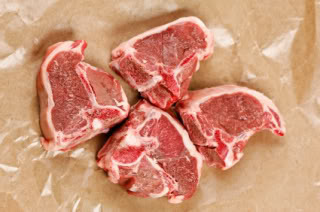 I hope everyone is enjoying the holidays. Since you’re likely busy with something or other, I’ll keep this week’s Dear Mark fairly brief. It’s a grab bag of questions again, beginning with a reader’s query about the grass-fededness (yep, that’s a word) of Australian lamb. Is it reliably pasture-raised, or are Australian producers beginning to load their lamb up with grains? Then, I discuss the efficacy (or not) of bathing in Epsom salts. Does the magnesium get absorbed, or doesn’t it? What about sea water in general – does spending time in it offer anything but a good time? Finally, the spectre of CLA supplementation arises yet again.
I hope everyone is enjoying the holidays. Since you’re likely busy with something or other, I’ll keep this week’s Dear Mark fairly brief. It’s a grab bag of questions again, beginning with a reader’s query about the grass-fededness (yep, that’s a word) of Australian lamb. Is it reliably pasture-raised, or are Australian producers beginning to load their lamb up with grains? Then, I discuss the efficacy (or not) of bathing in Epsom salts. Does the magnesium get absorbed, or doesn’t it? What about sea water in general – does spending time in it offer anything but a good time? Finally, the spectre of CLA supplementation arises yet again.
Let’s go:

Greetings Mark!
We were just wondering what your opinion was on grocery store bought lamb meat. The wife and I are new to a paleo lifestyle (a few weeks) and just recently purchased your book a week ago and are reading up on your PB. We are loving the difference this has made already in our lives. We have phased out regular beef for grass fed beef and made many other good changes. However, I can’t find a definitive answer regarding lamb meat online. It’s currently my view that since just about all of the lamb we buy comes from Australia then it must be grass fed by default. Just wondering if I’m wrong on this and what your opinion is.
Thanks and have a Great Day!
Grok On,
Robert
According to the North American regional office of Meat and Livestock Australia (MLA), which as far as I can tell supplies all the Australian lamb available in the United States, Australian lamb is “all-natural, grass-fed, pasture-raised and free of artificial additives and hormone growth promotants.” The only exception is during a drought, when “local feeding may, by necessity, be temporarily supplemented with grain, usually wheat and/or oats until the drought is alleviated.” Sounds nice, except when you realize that Australia has been subject to a decade-long drought which only recently ended.
I also came across this interesting page on the Sheepmeat Council of Australia’s website entitled “National Procedures and Guidelines for Intensive Sheep and Lamb Feeding Systems.” Note that these are “intensive” feeding systems, which tend to mean grain-feeding. It’s pretty tough to intensively feed a ruminant on grass, because grass simply doesn’t have enough energy density to qualify. They link to the PDF, and it’s pretty clear that Australian lamb is regularly receiving grain supplementation.
In lieu of full disclosure from the producer or vendor, you can usually tell if lamb has been grain-fed for a significant part of its life by examining it. Fully grass-fed lamb will be deep red, bordering on purple. The meat will be firm, not squishy. It’ll be leaner than grain-fed (but not “lean,” necessarily), and its fat should be a bit yellow or off-white; grain-fed fat will be closer to pure white due to the lack of carotenoids in the diet. Taste will also tell the tale. The firmness of the meat should shine through when you bite into it. It should be “cohesive” in your mouth, if that makes sense, like a solid piece of well-worked muscle (since that’s what you’re eating, essentially). Grain-fed will be more porous.
You can also compare the Australian lamb to New Zealand lamb, which (as far as I’ve been able to discover) is always grass-fed.
Hey Mark,
Tons of sites talk about epsom salts and if you do a search on MDA there are tons of user comments on how they use epsom salts in the comments section after your articles. I’m curious on what your thoughts are. I assume that if Grok often lived by the ocean and ate salty sea creatures he must of spent a considerable amount of time in that salty water. Is there any benefit to regular dips in salty water?
Thank you!
Peter
Yeah, there are absolutely huge benefits to immersing yourself in salty water (preferably sea water) many of which have been explored in clinical trials. Let’s take a look at some of them, shall we?
Bathing in Dead Sea salts, also called Tomesa therapy, improved the skin health of patients with psoriasis and normalized the levels of Langerhans cells (a kind of macrophage that helps with tissue healing and can get out of control in certain skin diseases). A bath in regular sodium chloride (salt) had no effect. Another study found that magnesium-rich Dead Sea water improved skin hydration, skin barrier function, and reduced skin inflammation in atopic dry skin.
Bathing in the Dead Sea had a positive effect on patients with both rheumatoid arthritis and osteoarthritis by reducing inflammation. In osteoarthritis of the knee, a two week Dead Sea bath treatment resulted in a 3-month abatement of symptoms. A recent literature review concluded that the Dead Sea makes for an effective resort for patients with various types of joint ailments.
Also interesting is the effect on type 2 diabetics. A single immersion in the waters of the Dead Sea lowered blood glucose levels in type 2 diabetics.
Ben Greenfield reviewed the benefits and efficacy of magnesium bath salts in a post from last year. Myself, I can vouch that topical magnesium does “something.” I’ll occasionally spritz a few pumps of magnesium oil onto my body before bed or after getting out of a shower or bath, and my skin tingles and I tend to have really vivid dreams that night. The rib cage area seems to be the best spot for application. I always like to keep a sack of Epsom salts around to add a little magnesium to my bath, too.
And of course, my favorite way to bathe in sea salts is to swim in the actual, real ocean. It certainly has evolutionary precedent, as you mention above.
Hey Mark,
I have synthesized the primal lifestyle with the protocols of leangains and intermittent fasting. The results have been great and make me feel awesome. I lift all the heavy weights and sprint, although I admit I don’t move around as much as I should.
However, I have been taking a CLA supplement for at least a year or two now. It is supposedly derived from safflower oil and I typically take about 2-3 per day with meals. I know getting CLA from dietary sources is preferable but buying all the organic and grass fed meat is difficult with my budget (I still always buy organic eggs). I was wondering if taking the supplement while eating conventional meat was still headed in the right direction. Any insight on the subject would be much appreciated.
Thanks a bunch and keep doing what you do!
Karson
CLA supplements sound like a good idea. Grass-fed dairy and ruminant meat are expensive, and part of the reason we like them so much is the conjugated linoleic acid, so why not just take the CLA and eat regular meat and dairy?
As I explained in a previous post, not all CLA is created equal. The kind that’s produced in ruminant stomachs – and the kind that you’re generally going to encounter in the wild, in naturally-occurring foods – is primarily cis-9, trans-11, with a tiny bit of trans-10, cis-12. The kind that’s produced from safflower oil is primarily trans-10, cis-12. Okay, but does that really matter?
Oh yeah. See, the trans-10, cis-12 CLA actually appears to perform really well in clinical trials. It abolishes fat mass and increases lean mass, which generally correlates well with improved health overall. That’s what you’d think, at least. But no – this time, the people (and mice) who lose the body fat and increase the lean mass, who experience the “benefits” of safflower-derived CLA do so by shunting all the fat toward an organ you definitely do not want to fatten up: the liver.
More evidence keeps accumulating: CLA supplements – in sufficient dosages – consistently increase liver fat, worsen blood lipids, decrease insulin sensitivity, and destroy glucose tolerance. But hey! At least you might get a six pack in the process!
I would avoid CLA supplementation. It might be okay, provided you stick with small doses (2-3 per day sounds like a fairly small, inoffensive dose), and it might be even better if you took a CLA supplement that mimicked the ruminant form, but I don’t think it will do you any favors. If you’re going to insist on taking them for an extended amount of time, I would get regular liver function tests to ensure you’re not doing any harm.
Get the Primal Blueprint Fitness eBook, Free Health Tips and Primal Recipes Delivered to Your Inbox

December 23, 2012
Weekend Link Love
 If you are convenient to Phoenix, AZ, don’t miss this awesome 2013 kickoff event – a combination Primal Transformation Seminar and spectacular Primal Cooking Class! Brad Kearns will present the popular seminar on the heels of his 20-city nationwide tour last winter. He’ll be joined on stage by very special guest Tara Grant, whose remarkable success story has been featured on MDA as well as in The Primal Blueprint 21-Day Total Body Transformation. Immediately following the seminar will be Chef Rachel’s lauded Primal cooking performance/presentation/party that has been a huge hit at the last three PrimalCon events. This event is limited to 40 attendees, so act fast before they’re sold out.
If you are convenient to Phoenix, AZ, don’t miss this awesome 2013 kickoff event – a combination Primal Transformation Seminar and spectacular Primal Cooking Class! Brad Kearns will present the popular seminar on the heels of his 20-city nationwide tour last winter. He’ll be joined on stage by very special guest Tara Grant, whose remarkable success story has been featured on MDA as well as in The Primal Blueprint 21-Day Total Body Transformation. Immediately following the seminar will be Chef Rachel’s lauded Primal cooking performance/presentation/party that has been a huge hit at the last three PrimalCon events. This event is limited to 40 attendees, so act fast before they’re sold out.
Research of the Week
The human hand may be uniquely “designed” to form a fist that’s perfect for the concentrated application of force. Meaning, punching each other could have shaped human evolution, and the ability to form a fist isn’t just an accident.
Applying physical pressure to malignant mammary cells was able to redirect their growth into a healthy pattern away from cancer. In other words, you now have a persuasive excuse to squeeze your partner’s breasts.
Interesting Blog Posts
Ben Greenfield outlines his race day nutrition that allowed him to eat fewer calories and still torch the competition at the Leadman Triathlon.
That Paleo Guy returns with a nice long rant about calories and the futility of thinking of humans as walking bomb calorimeters (with more to come).
Media, Schmedia
What we can probably learn from hunter-gatherers about how to raise our children.
Man, just look at this horrible kale-ridden eyesore! How do neighbors stand it?
Robb Wolf, Chris Kresser, Gary Taubes, Michael Eades, and yours truly all made Greatist’s 100 Most Influential People in Health and Fitness for 2012. Congrats, all!
Everything Else
For a truly last-minute gift idea, consider Cranky McSlacker’s $3.99 fitness e-book, Cranky Fitness: Exercise Your Ass Off. It’s a simple and effective book geared toward the person who really doesn’t like exercising, but knows they need to do something. Cranky helps you figure out what you can do without wanting to kill yourself so that you don’t end up killing yourself from inactivity. Check it out!
I wonder how a similar video filmed in today’s high schools would turn out.
This virtual fireplace from Applegate Farms should really warm your cockles. Specifically, cockles sautéed in bacon fat.
Recipe Corner
You haven’t tasted heaven (literal “angel feathers, spittle flying from the mouth of the eternal chorus” heaven) until you’ve had bacon-wrapped, goat-cheese stuffed dates.
Speaking of bacon (yes, that’s thrice I’ve mentioned it), how about trying bacon sushi?
Time Capsule
One year ago (Dec 23 – Dec 29)
How to Interpet Advanced Cholesterol Test Results – Once you finally convince your doctor to order the tests, here’s how to figure out what’s going on.
An Open Letter to Kids and Teens (and Infant Prodigies) – Why, and how, kids and teens should start getting healthy now – while they still can!
Comment of the Week
I hear ya. Whenever someone talks trash about the mesozoic era makes me want to fight.
- Word, Paleo Bon Rurgundy.
Get Your Copy of Primal Blueprint Healthy Sauces, Dressings & Toppings Today!

December 22, 2012
Lamb Rib Chops with Parsley and Mint Sauce
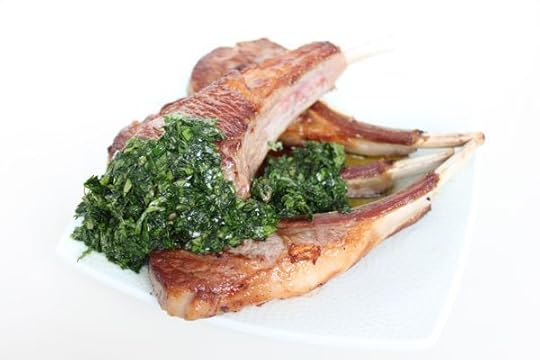 These little lamb chops are incredibly easy to cook but always seem so fancy, especially when dressed up with a vibrant herb sauce. Whether served for a holiday feast or mid-week meal, you’re in for a real treat when you serve lamb rib chops with parsley and mint sauce.
These little lamb chops are incredibly easy to cook but always seem so fancy, especially when dressed up with a vibrant herb sauce. Whether served for a holiday feast or mid-week meal, you’re in for a real treat when you serve lamb rib chops with parsley and mint sauce.
Lamb rib chops are tender morsels that only need a few minutes over a flame to crisp up before they’re done. Sear the chops in a cast iron pan, or on a grill, or under a broiler. They just might be one of the easiest cuts of lamb to cook and the meat is reliably juicy and flavorful.
There’s no need to worry about a marinade. The herb sauce is so fresh and lively that it provides all the extra flavor the delicate chops need. Take time to finely chop and mix the sauce by hand. The chunky texture and fresh flavor taste better that way, instead of being whirred up in a blender.
Don’t bother serving knives; the best way get all the tender meat and crispy fat off the bone (even at a fancy party) is to eat with your hands and gnaw away.
Servings: Three to four. Plan for at least two chops, probably more, per person.
Time in the Kitchen: Thirty minutes
Ingredients:

8 lamb rib chops
2 tablespoons coconut oil (30 ml)
4 garlic cloves, finely chopped
1 cup finely chopped fresh parsley (250 ml)
1/3 cup finely chopped fresh mint leaves (75 ml)
4 oil-packed anchovies, drained and very finely chopped
Zest from one lemon
1/2 cup olive oil (125 ml)
Salt and pepper to taste
Instructions:
Combine the coconut oil and garlic, and rub into the lamb chops. Note that adding the garlic ahead of time means it will cook with the lamb and become really browned. If you’re worried about the garlic burning, then only rub the meat down with oil and then add the garlic to the pan during the last two minutes of cooking the chops.

Lightly salt and pepper the meat. Set aside.
In a medium bowl use a fork to mix together the parsley, mint, anchovies and lemon zest. Drizzle in the olive oil, mixing and mashing the sauce with a fork. Set aside.
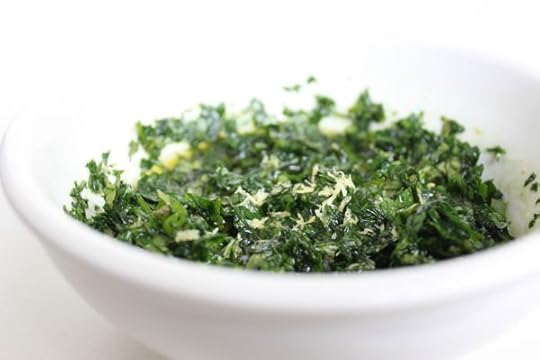
Heat a cast iron pan over medium-high heat. The pan should be hot but not smoking when you add the chops, four at a time. Cook for about six to eight minutes total, flipping midway through. The outside of the lamb should be nicely browned and crispy. The middle should be rare to medium-rare.
Cook the second batch of chops. Serve with the sauce.
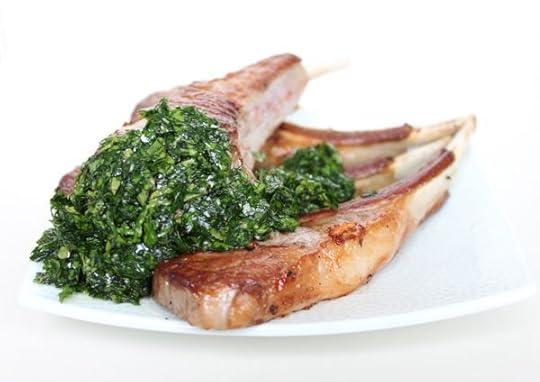
Get Your Copy of Primal Blueprint Healthy Sauces, Dressings & Toppings Today!

Mark Sisson's Blog
- Mark Sisson's profile
- 199 followers



